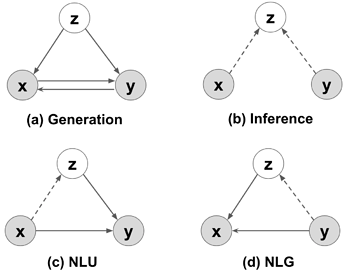This paper proposes a novel joint framework for NLU and NLG using neural variational inference. Their method is capable of supervised, on-the-fly data augmentation and semi-supervised learning.
Following the standard variational inference, a latent variable z shared by the natural utterance x and the formal representation y is introduced.
As NLU is a many-to-one mapping problem, for NLU \mathbf{z} is sampled from a normal distribution
where the mean and variance is learnt by some RNN models. NLG is instead a one-to-many problem so for NLG the mean vector \pmb{\mu}_{x,z} is used as \mathbf{z}.
Once \mathbf{z} is determined, it is concatenated with the decoder hidden states for NLU/NLG prediction.
For optimization, standard variational lower bound can be optimized for p(x,y) and p(x) or p(y). Depends on wether this x or y comes from auto-encoders or unlabelled data, the learning is called data-augmentation (marginal) or semi-supervised. In summary, the following optimizations are supported:
Comments
- Beautiful, what else can I say?
- I feel once graph encoder and decoder become matured, this method will bring us more benefits.
- 5: Transformative: This paper is likely to change our field. It should be considered for a best paper award.
- 4.5: Exciting: It changed my thinking on this topic. I would fight for it to be accepted.
- 4: Strong: I learned a lot from it. I would like to see it accepted.
- 3.5: Leaning positive: It can be accepted more or less in its current form. However, the work it describes is not particularly exciting and/or inspiring, so it will not be a big loss if people don’t see it in this conference.
- 3: Ambivalent: It has merits (e.g., it reports state-of-the-art results, the idea is nice), but there are key weaknesses (e.g., I didn’t learn much from it, evaluation is not convincing, it describes incremental work). I believe it can significantly benefit from another round of revision, but I won’t object to accepting it if my co-reviewers are willing to champion it.
- 2.5: Leaning negative: I am leaning towards rejection, but I can be persuaded if my co-reviewers think otherwise.
- 2: Mediocre: I would rather not see it in the conference.
- 1.5: Weak: I am pretty confident that it should be rejected.
- 1: Poor: I would fight to have it rejected.
0 投票者

